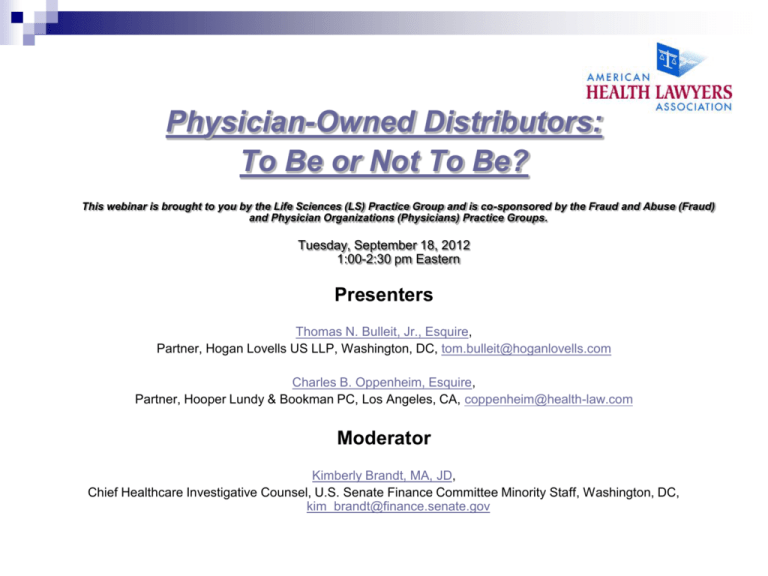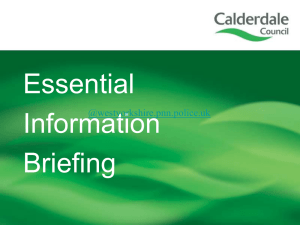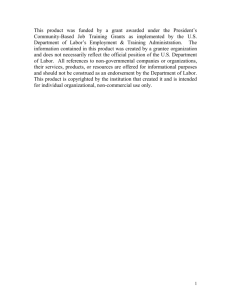
Physician-Owned Distributors:
To Be or Not To Be?
This webinar is brought to you by the Life Sciences (LS) Practice Group and is co-sponsored by the Fraud and Abuse (Fraud)
and Physician Organizations (Physicians) Practice Groups.
Tuesday, September 18, 2012
1:00-2:30 pm Eastern
Presenters
Thomas N. Bulleit, Jr., Esquire,
Partner, Hogan Lovells US LLP, Washington, DC, tom.bulleit@hoganlovells.com
Charles B. Oppenheim, Esquire,
Partner, Hooper Lundy & Bookman PC, Los Angeles, CA, coppenheim@health-law.com
Moderator
Kimberly Brandt, MA, JD,
Chief Healthcare Investigative Counsel, U.S. Senate Finance Committee Minority Staff, Washington, DC,
kim_brandt@finance.senate.gov
Key Fraud and Abuse Laws
Stark Law – Also Referred to as Physician Self-Referral Law
Anti-Kickback Statute
Stark Law
•
Prohibits a physician from making referrals for certain designated health services
(DHS) payable by Medicare to an entity with which he or she (or an immediate family
member) has a financial relationship (ownership, investment, or compensation),
unless an exception applies
•
Prohibits the entity from presenting or causing to be presented claims to Medicare
(or billing another individual, entity, or third party payer) for those referred services.
•
Establishes a number of specific exceptions and grants the Secretary of the
Department of Health and Human Services the authority to create regulatory
exceptions for financial relationships that do not pose a risk of program or patient
abuse.
The Anti-Kickback Statute
•
Prohibits anyone from purposefully offering, soliciting, or receiving
anything of value to generate referrals for items or services payable by
any Federal health care program
•
42 states and D.C. have enacted their own anti-kickback statutes
Physician Owned Distributors (PODs)
In Spring 2011, Senate Finance Committee began
looking at PODs to determine what role they played in
the marketplace.
Sent letters to CMS and OIG in June 2011 asking for
specific information about the role of PODs and how
CMS/OIG current and future authorities addressed
PODs.
PODs, Cont.
In their 2012 work plan, OIG has included a study
looking at the impact of PODs.
Senate Finance has held numerous meetings with
individuals and entities to better understand the role of
PODs.
To date, no determination as to the benefit/detriment of
PODs has been issued by the Finance Committee.
Physician-Owned Distributors and Device
Companies
Charles B. Oppenheim, Esquire, Hooper Lundy & Bookman PC,
Los Angeles, CA, coppenheim@health-law.com
PHYSICIAN-OWNED DEVICE
COMPANIES
Boon
or Boondoggle?
Who is for/against them?
Big
Device Companies
Their Competitors & Hospitals/Physicians
When
you’ve seen one physicianowned device company, you’ve seen
one physician owned device company
8
PHYSICIAN-OWNED DEVICE COMPANIES: LEGAL LANDSCAPE
Federal
Anti-Kickback Statute
Federal Physician Self-Referral
Statute (the “Stark law”)
State Equivalents
9
FEDERAL ANTI-KICKBACK STATUTE
Understanding the “one purpose” test
What does it mean to intend to “induce” someone?
Encouragement v. Inducement (“an intent to exercise influence
over the reason or judgment of another”)
(Hoping, expecting or believing referrals may ensue from
remuneration is not the same as inducement)
What does “knowingly and willfully” mean?
10
Stated in cases; repeated by OIG
To what extent is it dicta?
High level of scienter
Knowing you are breaking the law or knowing your conduct is
wrongful or corrupt is necessary
FEDERAL ANTI-KICKBACK STATUTE (Cont’d)
Potentially applicable to
Physician-Owned Device
Companies in Two Ways:
Is
11
investment in Company
inducement to physicians to order
company’s devices?
Is the hospital’s purchase of
devices inducement to physicians
to refer patients?
HANLESTER
Physician-owned laboratories
OIG asserted profit shares were illegal
inducements
Court rejects OIG’s position, and holds
physician investments are permitted
under the anti-kickback statute
But, certain elements that tie the
investment too closely with referrals can
result in illegality
12
HANLESTER (Cont’d)
What’s okay?
What’s not okay?
13
Selecting investors based on potential for referrals
High profits to investors
Venture dependant on physician investor referrals
But, return on investment must be based on ownership
percentage, not referrals
Implying that eligibility to purchase an investment interest in the
business depends on an agreement to make referrals;
Telling investors that the size of the investment interests they
would be allowed to purchase would depend upon the volume of
business they referred; or
Stating that partners would be pressured to leave the
partnerships if they did not make referrals
HOSPITAL – POD ARRANGEMENT (Kickback
Compliance)
14
Written purchase and sale agreement
Fair market value prices (volume discounts are okay;
increases based on referrals aren’t okay)
No coercion by physician; no leveraging referrals
Prices and other terms equal or better than nonphysician owned vendors for comparable items
ANTI-KICKBACK -- RECENT SETTLEMENT
UNITED SHOCKWAVE SERVICES, UNITED PROSTATE
CENTER, UNITED UROLOGY CENTERS
15
OIG alleged physician owners of lithotripsy companies
“leveraged” their referrals to get business
Lithotripsy companies paid $7.3 million to settle
Problem was alleged link between using physicianowned business and physician referrals, i.e., physicians
using the leverage of their referrals to pressure hospital
to purchase from their business
STARK LAW
POD sells devices
POD
PHYSICIAN
OWNER
16
Payments per device
HOSPITAL
PHYSICIAN
OWNER
Under indirect analysis the “aggregate” compensation received by
POD varies with referrals to hospital, so physician owners have an
indirect compensation arrangement with hospital
STARK LAW: INDIRECT COMP. EXCEPTION
Requires
a written agreement
Fair market value compensation that
does not vary with referrals (note that
per use payments are ok if the rate
of payment does not increase with
referrals)
Arrangement must not violate the
anti-kickback statute
17
PRACTICAL POINTERS & BEST PRACTICES:
The following “do’s and don’ts” are
intended to provide practical advice
and identify best practices, but are
not necessarily absolute mandates
or prohibitions in every case.
18
PRACTICAL POINTERS & BEST PRACTICES:
(Cont’d)
19
DO ensure that the Company provides the Hospitals with comparable (but
preferably better) prices and price terms for the products, consistent with
fair market value, than the Hospitals would be able to obtain if they
purchased the products (or comparable products) from alternative
sources.
DO ensure that the Company offers the hospitals commercially
reasonable representations, warranties, return policies, shipment terms
and other non-price contract terms that are equal to or better than other
vendors of comparable products, using signed, written agreements.
DO have the Company employ its own personnel, who are well-trained on
regulatory compliance issues and who perform the Company’s marketing,
contract negotiations, and billing and collections.
PRACTICAL POINTERS & BEST
PRACTICES: (Cont’d)
20
DO encourage Hospitals to provide all the physicians on the medical staff
with a choice of whichever products they prefer to use in their surgeries, and
discourage the Hospitals from contracting with the Company on an exclusive
basis or carrying the products exclusively.
DO ensure that the Company enters into its own contracts with vendors,
maintains, manages and ships from its own inventory, and bills in its own
name.
DO make sure the devices are of high quality and FDA approved.
DO ensure that any and all products acquired by the Company from
manufacturers and/or vendors are purchased as true sales, not as part of a
consignment arrangement, and are paid for with cash, not financed by the
manufacturers and/or vendors.
PRACTICAL POINTERS & BEST PRACTICES:
(Cont’d)
DO ensure the Company is adequately and
appropriately capitalized and insured, as
reasonable and customary for a medical
device distributor, and that investments made
by physician owners are not nominal in
amount.
DO ensure that the return on investment received by
each investor in the Company is directly proportionate to
such investor’s ownership interest, without regard to the
volume or value of products used by such investor (if
any).
DO ensure that the use of the products in all instances
is medically necessary.
21
PRACTICAL POINTERS & BEST PRACTICES: (Cont’d)
22
DON’T require, coerce or pressure any hospital to
contract with the Company or purchase products,
including but not limited to any explicit or implicit threat
that any of the physician’s future referrals to the Hospital
might be conditioned on or related to whether or not the
Hospital chooses to contract with the Company or how
much (if any) of the products a hospital might or might not
purchase from the Company.
DON’T alter the size of the investment opportunity in the
Company offered to physician investors based on the
expected or actual volume of products used by such
potential physician investor.
PRACTICAL POINTERS & BEST PRACTICES:
(Cont’d)
23
DON’T guarantee any physician a return on his or her investment in the
Company.
DON’T permit the Company to loan any money to an investor or potential
investor, including, without limitation, financing any investor’s acquisition of
an interest in the Company or guaranteeing any loan taken out by an
investor.
DON’T provide the Company with the right to repurchase any investor’s
interest for failing to use the Company’s products (or failing to use any
particular volume of such products).
DON’T permit the Company to enter into any compensation or other
arrangement with any physician that is not both commercially reasonable and
consistent with fair market value, without taking account of the amount of
products (if any) ordered or used by such physician.
Physician-Owned Distributors:
To Be or Not To Be?
Tom Bulleit, Hogan Lovells US LLP, Washington DC
tom.bulleit@hoganlovells.com
Summary of Presentation
What is a POD?
Do PODs Violate the Antikickback Law?
What About the Stark Law?
Are PODs at risk under the False Claims Act?
Are there Mitigating Features That Would Deter
Enforcement Against Pods?
Conclusions
What is a POD?
A physician-owned distributor (POD) is an entity that
recruits implanting surgeons as investors, thereby sharing
with the physicians profits from the purchase by hospitals
of the devices that they implant in their patients at
hospitals that have agreed to purchase through the POD
PODs are one of several types of physician-owned
implant companies (POCs). POCs take several forms,
including manufacturers, GPOs, and PODs.
The prevailing POD model is a “stocking distributor” (buys
and resells inventory)
Do PODs Violate the Federal Antikickback Law?
AKL prohibits any remuneration to induce physicians to
purchase or order (or arrange for purchase or order of)
products, or refer patients for a procedure, for which
payment may be made under Medicare/Medicaid/Other
FHCPs1
Orthopaedic/spinal implants used in FHCP patients are deemed
paid for in the payment to the hospital or ASC
Remuneration includes return on investment (Hanlester) and the
opportunity to earn a profit (Bay State)2
Law is violated if one purpose is to induce the prohibited
purchase, order or referral, even if there are other legitimate
purposes
Do PODS Violate the Federal AKL?, cont.
Who is at risk under AKL?
Is one purpose of the investment opportunity to induce
physician’s to order a manufacturer’s implantable devices?
If yes, the physician and the POD’s other entrepreneurs are at risk
for receiving the investment return, and
The manufacturer is at risk for creating the profit opportunity by
selling to the POD
Is one purpose of the investment opportunity to induce
physicians to refer their patients to hospitals who agree to buy
through the POD?
If yes, the hospital is also at risk for creating the profit opportunity by
purchasing from the POD
Do PODs Violate the Federal AKL?, cont.
There are only two essential elements for an AKL
violation:
Is there remuneration to a referring physician?
Is one purpose of giving the physician the remuneration to
induce the physician to order covered product or make a
covered referral?
If these elements are present, then the participants are
solely in the realm of prosecutorial discretion as to
whether they are subjected to the AKL’s sanctions
Civil money penalty and exclusion by OIG
Direct criminal proceeding by DOJ
Qui Tam proceeding under the False Claims Act
Do PODs Violate the Federal AKL?, cont.
Essential Element #1: Is there remuneration?
Remuneration includes the opportunity to earn money (Bay
State) and return on investment (Hanlester)
Investment return is not protected simply because it is
proportional to the amount invested, or otherwise has the indicia
of a “legitimate” investment, but only if it is not motivated by
improper intent (Hanlester, JV Fraud Alert)3
Recently affirmed in OIG Advisory Op 11-15 (declining to approve
physician-owned lab management agreement despite returns being
proportional to investment interests)
Do PODs Violate the Federal AKL?, cont.
Essential Element #2: Is there an unlawful intent to
induce?
Unlawful inducement means “an intent to exercise influence over
the reason or judgment of another in an effort to cause the
referral of program-related business.” (Hanlester)
So, is one purpose of giving the physicians the opportunity to profit
from their investment to affect their judgment about which implant or
which hospital to use?
Direct evidence of unlawful intent is not required, but may be
inferred from the surrounding circumstances
Is there really any doubt that unlawful intent could be inferred in
every POD arrangement?
Do PODs Violate the Federal AKL?, cont.
Failure to follow OIG Guidance is evidence from which
unlawful intent may be inferred
Hornbook administrative law: Agency interpretations are entitled
to deference when a court is required to test a regulated
person’s conduct against that interpretation. E.g. Chevron4
Deference due even under a criminal statute if it is being enforced
only civilly. E.g. Sash v. Zenk5
Hanlester court acknowledged that absence of liability for some
of the Hanlester defendants was because at the time the
arrangements were entered into, joint ventures of that kind were
fairly common and were not per se unlawful, and recognizing
that OIG’s first JV guidance was not issued until after the events
underlying the prosecution took place6
Do PODs Violate the Federal AKL?, cont.
Hanlester case, often cited by POD proponents as
evidence that “legitimate” investments do not violate the
AKL, is of little relevance to PODs, e.g.
Hanlester was decided based on facts that preceded any OIG
guidance on physician investment interests
Hanlester applied to investment in a supplier of health care
services (clinical laboratory), not an unregulated entity
In Hanlester there were a substantial number of investors
diluting the effect of referrals; PODs involve small numbers of
investors;
In Hanlester there were no findings concerning excessive return
on investment, unnecessary services, or potential harm to
patients
Do PODs Violate the Federal AKL?, cont.
OIG agency guidance concerning physicianowned entities is now open and notorious
Special Fraud Alert on Joint Venture Arrangements (1989)
Safe Harbor Regulations (1994)
Investment return constitutes remuneration
More than 40% of revenues from referring investors fails
Special Advisory Bulletin on Contractual Joint Ventures
Emphasizes choice of referring investors and “shell” business structure outsourcing key
functions
Demonstrates continuing concern with outsourcing and profit from passive referrals
United Shockwave Settlement (2010) “We continue to have serious kickback
concerns when companies link investment opportunities to the ability to generate
business and offer returns on investment that are disproportionate to business
risk.”
Do PODs Violate the Federal AKL?, cont.
Advisory Opinion 11-15 Suspect Physician Investment:
Management fee not saved even though each doctor’s return was
proportional to his investment interest, because overall the
entity’s revenues (and profits) were based on volume/value of
aggregate referrals of all the physician investors
More than 40% of revenue from the referring investors
Fact that owners had no experience in lab services but could
refer suggests that there is no purpose other than to permit
physician investors to profit from their own referrals
Do PODs Violate the Federal AKL?, cont.
Management Company Advisory Opinions
OIG has failed to grant approval of provider investment in
management company arrangements designed to exploit the
provider’s referral base
98-4 (physician practice management services), 03-08 (inpatient
rehabilitation unit management services); 06-02 (DME/orthotics
delivery management, coding, billing and collection, and leased
technician services); and 11-03 (long term care pharmacy
management services)
Do PODs Violate the Federal AKL?, cont.
Recent government statements echo concerns
OIG (2006, 2008): PODs “should be closely scrutinized under the fraud and
abuse laws” because relationships between manufacturers and physicians “raise
the type of risks that [the anti-fraud and abuse] statutes were designed to
address.”
CMS (2008): PODs “may serve little purpose other than providing physicians the
opportunity to earn economic benefits in exchange for nothing more than ordering
medical devices” from their POD.
Senate Finance Committee (2011): PODs “seem to create financial incentives for
physician investors to use those devices that give them the greatest financial
return and that, in the process, patient treatment decisions may be based on
personal financial gain.”
Senate letter does NOT indicate that some PODs are OK: its only example of a
potentially lawful POD is one that does not sell to hospitals where the investor physicians
practice
OIG response does NOT indicate that some PODs are OK: it simply lays out the factors
that OIG uses in analyzing physician investment
Do PODs Violate the Federal AKL?, cont.
PODs implicate the OIG’s suspect factors
Investor recruitment and retention
PODs recruit investors in position to make referrals and encourage investors
to refer
POD owner: “My idea was to form a limited liability company that consisted
of approximately one hundred doctors who would also act as the company’s
customer base…this concept created a built in market” for POD products7
Financing and profit distribution
Little if any business risk: POD is both buyer and seller, capital invested is
not substantial, returns on investment exceptional
Some PODs have advertised 25% return on investment, and one uses
assumptions of $2,750 purchase price per 1% ownership share, and $3,770
annual return per 1% ownership share8
Do PODs Violate the Federal AKL?, cont.
Business structure
Captive referral base
PODs often are “shell” entities that outsource principal operations
POD organizations market “turn-key stocking distributorship” and
management of “every step of the project”9
POD advertisements state “in the beginning, physician investors may be the
only users of your distribution company’s implants … the pro forma is based
on 80% of the physician investors’ annual surgical cases”10
Investment interests safe harbor not available because PODs do not
meet “40% test” – typically all POD business generated by investors,
and SH requires that no more than 40% of a venture’s revenues may be
generated by investors in position to make or influence referrals
PODs are different from other approved physician
ownership models
Other physician ownership models contain protective factors
that PODs lack
Joint ventures like ASCs and physician-owned hospitals are
regulated providers subject to licensure and clinical oversight
They also have mechanisms in place to track factors like
utilization and medical necessity
No similar checks and balances are present in PODs
PODs are not themselves Medicare providers or suppliers and
do not have to meet conditions of participation, utilization review,
licensure standards
PODs are not gainsharing
OIG has approved “gainsharing” models in which physicians
share in demonstrated cost savings
PODs are different because physicians share in profits, not in
cost savings
Money earned through POD is markup on implant sale price
Profits are maximized not by generating cost savings but by
ordering more, and more expensive, products
Gainsharing arrangements have safeguards against patient
and program abuse
Freedom to choose any product, limited to one year, ceiling on
amount that can be earned based on historical practice patterns
What About the Stark Law?
Stark prohibits physicians from making
Medicare referrals for certain designated health
services to an entity with which they have a
financial relationship absent an exception
Inpatient and outpatient hospital services,
including implant surgeries, are “designated
health services”
What About the Stark Law?, cont.
The Arguably relevant exception is for Indirect
Compensation Arrangements
Not available if arrangement violates the AKL
In any event allows hospitals to pay physician-owned entity if the
payment is FMV and doesn’t vary based on v/v referrals, defined
to allow per unit payments
Query whether a purchase from a POD that adds no value to the implant
purchase transaction could meet FMV standards?
Query whether when the hospital confers on the physician the opportunity to
profit by agreeing to purchase from his POD,
that is a separate stream of direct remuneration, for which the Indirect Comp
exception would not be available, or
fails the exception because that opportunity to profit is conferred only because of
the volume or value of referrals, and is not eligible for the per unit qualifier
What is the risk under the False Claims Act?
Every claim submitted to Medicare pursuant to a referral
prohibited under Stark or the AKL is a False Claim (cites)
As discussed above, there is ample basis for the
government, or a qui tam relator to bring a case
Anyone who is disadvantaged by the advent of a POD can bring
a qui tam case
Consequences of losing such a case are catastrophic
Just the expense and difficulty of having to defend such a
case will strain the resources of a hospital or a
manufacturer, and could be ruinous to a physician
practice
Other Risks to PODs?
Becoming a product supplier carries with it products
liability risk and FDA reporting requirements
When physicians become POD owners, they become resellers
of implants and are subject to products liability lawsuits.
They also become subject to FDA reporting requirements and
fall under FDA jurisdiction for enforcement of adulteration and
misbranding violations.
Are there Mitigating Features That Will Deter Enforcement
Against Pods?
Price of Implants? Proponents claim prices are going up, but
the average sales price of spine implants has decreased since
2008 and the average sales price of hip/knee implants has
remained relatively flat since 200511
Cost Savings? Aligning hospital/physician interests to improve
quality and control cost is the essence of Accountable Care,
which doesn’t depend on PODs
Innovation? If all is about the lowest cost implants, product
innovation and improvement is deterred, to the detriment of
patient care
Competition? PODs don’t increase competition – they
eliminate competition
Conclusions
The case that the basic POD model violates the AKL is simple
and strong
Easy to infer that one purpose of every POD is that financial
benefit will influence the judgment of the investor-physician on
product and hospital choice
That is all that’s necessary to make an AKL case
Relying on prosecutorial discretion is a questionable business
strategy
Adjunct case may be made under Stark, both because of the
AKL violation and based on arguments about indirect
compensation exception
False Claims Act provides a vehicle for disgruntled
competitors and others to act while government bides its time.
Endnotes
9.
42 U.S.C. § 1320a-7b(b).
SeeHanlester Network v. Shalala, 51 F.3d 1390, 1401 (9th Cir. 1995) (affirming the finding of the Department of
Health and Human Services Departmental Appeals Board that the opportunity for physician investors to earn
money from their investment in a laboratory partnership was remuneration for purposes of the anti-kickback
statute), See United States vs. Bay State Ambulance and Hospital Rental Services, Inc., 874 F.2d 20, 29 (1st
Cir. 1989) (“[g]iving a person an opportunity to earn money may well be an inducement to that person to channel
Medicare payments toward a particular recipient”).
See Hanlesterand Dep’t Health & Hum. Servs., Office of Inspector Gen., Special Fraud Alert: Joint Venture
Arrangements (August 1989), reprinted at 59 Fed. Reg. 65,372, 65,374 (Dec. 19, 1994).
Chevron v. National Resources Defense Council, 467 U.S. 837, 843–44 (1984).
439 F.3d 61 (2d Cir. 2006).
51 F.3d at 1394-95, 1399, 1401; Inspector Gen. v. Hanlester Network et al., [1991-2 Transfer Binder] Medicare &
Medicaid Guide (CCH) ¶ 27,757.
SouhailToubiaAff.¶ 2, Allez Med. Applications v. Allez Spine (Cal. Super. Ct. Apr. 14, 2006).
See, e.g., Omega Solutions Physician Recruitment Letter, Alliance Surgical Distributors “Financial
Considerations” material.
See Alliance Surgical Distributors physician information packet.
10.
Id.
11.
For implant average sales price data, see Orthopedic Network News, “Hospital Resources and Implant Cost
Management,” July 2007-2012 and “Profile of Hospital Spine Programs,” October 2009-2011, available via
subscription athttp://www.orthopedicnetworknews.com.
1.
2.
3.
4.
5.
6.
7.
8.
Questions?
Physician-Owned Distributors and Device Companies: To Be or Not To Be? © 2012 is
published by the American Health Lawyers Association. All rights reserved. No part of this
publication may be reproduced in any form except by prior written permission from the publisher.
Printed in the United States of America.
Any views or advice offered in this publication are those of its authors and should not be construed
as the position of the American Health Lawyers Association.
“This publication is designed to provide accurate and authoritative information in regard to the
subject matter covered. It is provided with the understanding that the publisher is not engaged in
rendering legal or other professional services. If legal advice or other expert assistance is required,
the services of a competent professional person should be sought”—from a declaration of the
American Bar Association





![Domiciliary Care leaflet editted_new.doc[...]](http://s3.studylib.net/store/data/007119587_1-e85760c65789a5d1ecb4c83918ba0905-300x300.png)

